(Pszczyna, Poland to Oswiecim)
View 2008-05-29 Pszczyna, Poland to Oswiecim in a larger map
Highlights: easy morning ride with headwinds, visiting Auschwitz-Birkenau concentration camp in the afternoon
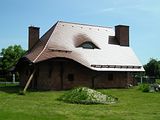
One-of-a-kind curvy house (Wola)
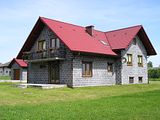
One of many cinder block homes (Wola)
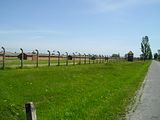
Around the bend...first view of Auschwitz camp II (Oswiecim)
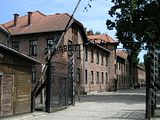
"Work Sets You Free"...entrance to Auschwitz camp I (Oswiecim)

Firing squad wall at camp I (Oswiecim)
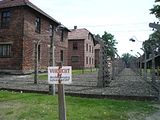
No way out (Oswiecim)
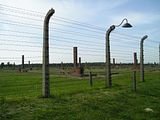
All that remains (Oswiecim)
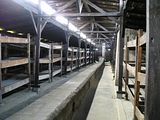
Where 500 prisoners "lived"...originally designed for 52 horses (Oswiecim)
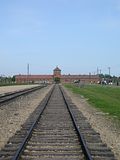
Well-known entrance to Auschwitz camp II (Oswiecim)
Journal: Today's ride was simple enough as we only rode 15 miles from the medieval-era center in Pszczyna to the former Nazi concentration camp at Auschwitz. After finding a set of maps to get us all the way to Krakow, there were no hills to slow us down today. However, the headwinds & rough riding surface at times were frustrating as I wanted to reach Auschwitz as quickly as possible in order to spend as much of the rest of the day visiting the museum & memorial. Then suddenly, out of nowhere, as we rounded a small bend in the innocuous rural countryside, we were there...standing at the edge of the notorious Auschwitz II concentration camp that housed more than 90,000 prisoners at once in 1944.
We had just a few minutes to spare before starting a four-hour guided tour (in English) in the afternoon. It was well worth the price (about $19 US) as we visited many of the buildings on the site of the smaller first camp (Auschwitz I), then took a bus over to the much larger second camp (Auschwitz II) several miles away. The tour itself was extremely helpful & tastefully done, but quite sobering nonetheless. The pictures I have seen before did not prepare me for the immense size of the second camp, which was built primarily to house & kill as many prisoners (mostly Jews) as possible. In total, more than one million people were deported to Auschwitz by the Nazis from 1942-1944; only 7000 survived to be liberated by the Soviets in January 1945. Nowadays, more than one million people annually visit the museum (which includes both camps) to see what is chronicled here. Exhibition signs are written in three languages (Polish, English & Hebrew) but guide books are available in many others. And while it was very crowded at times today (including a lot of school tour groups), I take it as a good sign that so many people are visiting here and choosing to remember rather than forget the past.
1 comment:
Dear John, It was great reading your latest journal entries. Your daily adventures are so different. I think you should write a book when you get back home. Daddy and I leave for Virginia on Tuesday morning. Things went extremely well in Sidney, and we were able to relax and enjoy the area. Lots of Love, Mom
Post a Comment